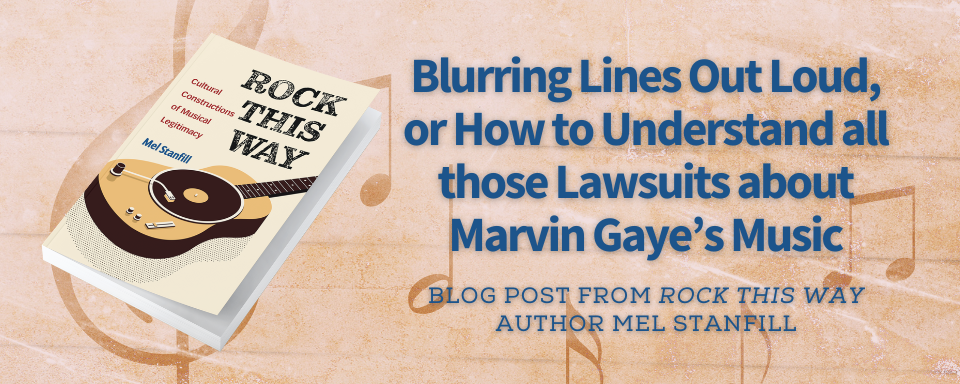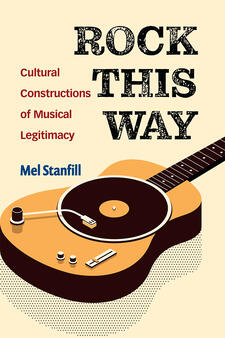Blurring Lines Out Loud, or How to Understand all those Lawsuits about Marvin Gaye’s Music

This guest author post is by Mel Stanfill, author of Rock This Way: Cultural Constructions of Musical Legitimacy, from the University of Michigan Press. The book is available in hardcover, paper, and open access.
In May 2023, a jury found that Ed Sheeran’s 2014 song "Thinking Out Loud" did not infringe on Marvin Gaye’s 1973 classic "Let's Get It On." Eight years earlier, a jury had found that Robin Thicke’s 2013 song “Blurred Lines” did infringe Marvin Gaye’s “Got to Give It Up” (1977). Listening to the two pairs of songs side by side, to my ear, the grooves of Sheeran’s song and Gaye’s are much closer. You might agree, or not, and that variability of interpretation turns out to be pretty important in how we make sense of music that builds on other music.
These songs are examples of what my new book, Rock This Way: Cultural Constructions of Musical Legitimacy, calls soundalike songs, songs reminiscent of existing songs without exact copying. The soundalike is similar to what musicologist J. Peter Burkholder (1994, 854) describes as “paraphrasing an existing tune to form a new melody, theme, or motive.” What my research on soundalikes finds is that the musical elements that United States law says are subject to copyright and the factors everyday people use to assess similarity don’t line up very well.
Rock This Way tries to understand how transformative music, meaning songs that build from existing music—cover songs, remixes, mashups, parodies, and soundalike songs—and rework the prior song in some significant way, are culturally understood. I’m interested in when music that builds from other music is or isn’t positively received, the structures of the music industry that enable or resist such works, and their encounters with copyright law, and I use the popular press as a way to gain insight into cultural perceptions. I understand race as central to the perception of transformative musical works, and so I look at how these points of contact between creativity and the law are shaped by the long history of overvaluing and overprotecting the work of white artists, undervaluing and underprotecting the work of Black artists (and other artists of color, but in the context of U.S. music, overwhelmingly Black artists), and treating Black artists under the rubric of what legal scholar Anjali Vats (2020) calls copyright thuggery—viewing them as thieves incapable of creativity. Ultimately, I show that the extent to which a transformative musical work is seen as having new expression or meaning is contingent on cultural notions of creativity, legitimacy, and law, all of which are structured by white supremacy.
With “Blurred Lines,” strictly speaking, as legal scholar Tim Wu noted in The New Yorker, “The question is not whether [songwriter] Pharrell borrowed from Gaye,” because clearly he did, “but whether Gaye owned the thing that was borrowed,” which Wu says he didn’t. As one article describes, “Yes, ‘Blurred Lines’ approximates the rhythm and timbre of ‘Got to Give It Up,’” but, the article asks, “is that theft? Listen. Both songs have cowbell-ish percussion that plunkity-plunks at a similar tempo, but the patterns are different. Both songs have rich, teasing basslines, but the notes and rhythms of each are dissimilar.” For people who think “Blurred Lines” shouldn’t have been seen as infringing, while there are definitely elements of the songs that are similar, the similarities are not the kind that are managed by copyright.
And it’s true that by the letter of the law, rhythm, background noise, falsetto, funky bass, cowbell, or any of the other elements are not relevant, either because they’re not original to Gaye, not copyrightable as part of a musical composition, or both. But these elements are relevant to how everyday people understand music, including jurors. The capital-L Platonic Ideal of the Law says one thing, but aspects of a song’s “feel” that don’t appear in sheet music are clearly relevant to listeners, including jurors and judges, which makes these aspects carry legal weight whether they’re supposed to or not. What the law says is not how people experience music, and neither is it how people hear similarity. Indeed, I would argue that, while none of the individual elements are unique to Gaye, the combination of them is what makes “Got to Give it Up”—and also what makes “Blurred Lines.” That’s not something existing law can account for, but it is experientially true, which has to be taken seriously even if only because it impacts verdicts.
One of the key issues in the “Blurred Lines” case—and looking back at earlier instances of soundalikes of Otis Redding, Stevie Wonder, etc. from Thicke—is that, as one article notes, he has been “accused of appropriating black music.” As anthropologist Maureen Mahon explains, while “borrowing and mixing are normal aspects of musical development,” a “dialectic of miscegenation and segregation surrounds the appropriation of black music by whites,” as “white appropriation of black sound and style was devastating to many of the music’s originators” (Mahon 2004, 148), because the financial and recognition benefits went to the white appropriators, not the originators. It isn’t that there should never be cross-racial or cross-cultural musical influence—indeed, it would be impossible to prevent it—but historically it has tended to be appropriative in the context of music (as in so many others). This is not borrowing and mixing on equitable terms.
Though historically, cultural appropriation has been mainstream and uncontroversial, there is a growing awareness of its ethical problems. The long history of white people stealing Black people’s music with impunity, from Elvis to the Rolling Stones to—in the words of The Simpsons—“Jimmy Page, one of the greatest thieves of American Black music to ever walk the Earth” (Kirkland 2003), is now increasingly seen as troubling, and this history hung over the “Blurred Lines” case. Growing negative attitudes toward cultural appropriation therefore had a lot to do with the fact that the legal strategy in the “Blurred Lines” case was to emphasize Pharrell Williams—a Black man—as the sole writer of the song. As one reporter noted when asking Thicke about the song, “you testified that you were intoxicated at the time of those press interviews and that you misrepresented both the extent of your role in writing the song and the influence of ‘Got to Give It Up’ on the song.” This would ordinarily be a strange legal approach, as it undermines the credibility of the lead plaintiff in the lawsuit—but it makes a lot of sense as an attempt to distance the song from that history of white people stealing Black people’s music.
That history of appropriation is why a lot of people saw the finding that “Blurred Lines” was infringing as reparative. One article explicitly describes a popular perception of the verdict as a correction of past wrongs: “An entire generation of American bluesmen died before sniffing the monthly private helicopter fuel budget of the rock-and-rollers who ran off with their sound. Others have settled out of court. And that’s one reason why a cheer went up on social media after Tuesday’s verdict was announced. This time, the young cads didn’t get away with it.” If past music industry practices hadn’t been so egregious, the “Blurred Lines” infringement verdict may never have happened.
However, there is more than one Black artist involved in “Blurred Lines,” complicating an easy reading of the verdict as restitution for white theft. On one hand, the song does represent and replicate decades of theft from Black artists through cover songs, shady contracts, and sonic pillaging. On the other hand, Williams’s involvement means it collides with practices of reference and reverence between Black artists. As hip-hop scholar Tricia Rose describes in the sampling context, such musical reuse “is about paying homage, an invocation of another’s voice to help you say what you want to say” (Rose 1994, 79). To think only about what’s lost or gained by Gaye’s estate is to miss this role of intra-group homage. This framing also displaces the fault for previous theft by white record executives and artists onto Williams.
This wasn’t a simple instance of Thicke as a white thief of Black artists’ music, but one that also touched on whether referential Black art forms like hip hop were legitimate. Who was doing the reusing matters—an interpretation that identifies Williams as the song’s sole author looks different from interpreting the emphasis on his authorship as strategically disclaiming Thicke as a co-author. In all of these ways, then, it is impossible to understand how people make social sense of soundalikes without race; as is clear from the “Blurred Lines” case, verdicts are ultimately deeply shaped by understandings around who did what to whom in terms of cultural appropriation and desires for restitution for harms.
References
- Burkholder, J. Peter. 1994. “The Uses of Existing Music: Musical Borrowing as a Field.” Notes 50 (3): 851–70. https://doi.org/10.2307/898531.
- Kirkland, Mark, dir. 2003. “The Regina Monologues.” The Simpsons.
- Mahon, Maureen. 2004. Right to Rock: The Black Rock Coalition and the Cultural Politics of Race. Durham: Duke University Press Books.
- Rose, Tricia. 1994. Black Noise: Rap Music and Black Culture in Contemporary America. 1st edition. Hanover, NH: Wesleyan.
- Vats, Anjali. 2020. The Color of Creatorship: Intellectual Property, Race, and the Making of Americans. 1st edition. Stanford, California: Stanford University Press.



